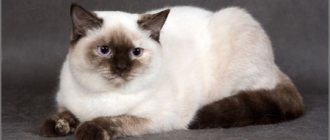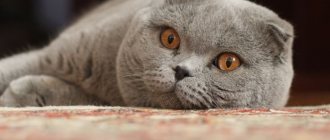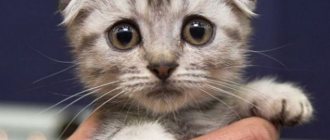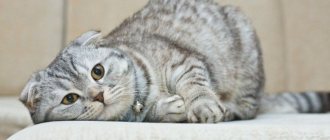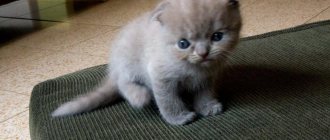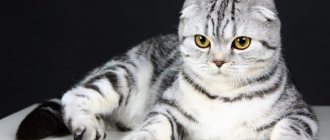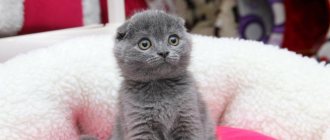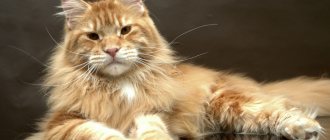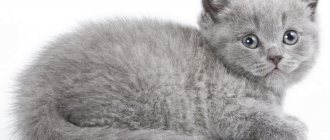Almost any person will be touched when they see a little fluffy dog with neat straight ears. The true loyalty, calmness and even character of the Scottish Straight cat, whose country of origin is cold Scotland, will make her an irreplaceable companion and a wonderful companion.
Scottish Straights are true Scots, considered a separate breed and somewhat similar to the British, but with a number of distinctive features.
Shedded (shaded)
With this type of color, two-thirds of the hair starting from the base is white, and the remaining part can be red, silver or gold. On the chin, belly and lower surface of the tail the color is light. The shaded color does not allow spots or stripes except those located on the forehead or paws.
Representatives of the Scottish breed with a similar color have white coat color as the main color, and the tail and muzzle are decorated with a different color or a combination of both (torti). There may also be spots on the body and paws.
What does Tabby mean?
Tabby is translated from English as “motley” or “striped”. It is also called patterned because of the contrast of color and brightness. The first spots appeared for the purpose of camouflage and protection. This allowed small animals to hide from large predators and approach their prey unnoticed. This is a characteristic color for the cat family, for example, like the Asian tabby in the photo.
There are no two individuals with identical patterns in nature.
There are a number of features that combine tabby cats:
- Eyes and nose outlined with edging.
- o on the forehead.
- Drawings as clear as a necklace.
- Individual speckles on the belly, arranged in rows.
Tabsty iris in warm shades:
- Copper;
- Amber;
- Light brown;
- Green;
- Yellow.
The distinctive tone, brightness, originality and uniqueness are valued by both pet lovers and pet experts.
The rarest colors of Scottish cats
Several years ago, the highest price was set for kittens of unusual silver and gold shades. But in the modern cat market there are more and more of them. Today, ticked Scots and golden chinchillas are considered the most expensive.
Scottish straight golden chinchilla
Interesting! The most common iris color among Scots is gold. However, there are some exceptions. Usually the eye color matches the coat. Blue or multi-colored eyes are quite rare, these animals can be white, bicolor or tortie. Orange iris is a very beautiful, but the rarest eye color in this breed.
Requirements for maintenance and nutrition
The character of the Scottish Fold cat is calm, imposing and lazy by nature. They require little space and time from the owner. However, there is a serious “but” in this characteristic - childhood and adolescence. During this period, the kitten is a perpetual motion machine with inexhaustible energy and imagination, for whose arrival the apartment must be prepared.
- Remove unnecessary items. Electrical wires, cables, charging gadgets, breakable things, as well as small objects that a kitten can swallow.
- Buy utensils for food and water. Use heavy ceramic or metal bowls to prevent your kitten from tipping them over.
- Buy a tray and filler. Decide where the cat will have a toilet, and from the first hour accustom him to one place. For a baby, a tray with low sides is better, but over time it will have to be replaced with a model with higher sides.
- Prepare your sleeping area. A special bed, house or folded blanket. The cat may get used to sleeping “at home”, or he may refuse to have his own place, but after the stress of moving, the kitten will most likely like his own independent cozy corner.
- Buy a carrier. Necessary for preventative visits to the veterinarian and travel.
- Buy a scratching post. It is necessary to accustom a cat to it from childhood so that it does not sharpen its claws on furniture and walls.
- Stock up on toys. A young Scot needs to be entertained and distracted from petty hooliganism, so the toys can be varied.
From the very first days, a Scottish kitten is taught to eat and use a toilet.
It is important to ensure that your pet only eats from a bowl, otherwise pieces of his food will end up on the carpet or sofa.
Often, a kitten is litter trained from the breeder under the mentorship of its mother cat. To ensure that the skill is immediately evident in your new home, take a sample of the smell and mark the new tray with it. In the first days, keep an eye on your pet if possible, and as soon as he starts fussing, take him to the tray. If something goes wrong, remove any traces of odor from the floor, otherwise the animal may think that the toilet is there.
Otherwise, caring for Scottish Folds is accessible even to inexperienced and very busy people. The main actions and their approximate frequency are described in the table.
Table - Caring for a Scottish Fold cat
| What to do | Frequency | Adviсe |
| Comb | - Once a week; - during the molting period - every day | — Use a special brush with non-sharp teeth; - comb the long-haired subspecies additionally with a comb |
| Bathe | Semiannually | - Make sure no moisture gets into your ears; - dry the coat and undercoat well |
| Trim claws | Once every 2-3 weeks | Use special pruning shears not close to the base |
| Clean ears | Once every 10-14 days | — Use a cotton swab (a cotton swab can damage your ear); - if there is purulent discharge with a characteristic odor - contact a specialist |
| Examine your eyes | Daily | — Wipe with a cotton pad; - contact your veterinarian if your eyes are watery for a long time, there is purulent discharge, or an unpleasant color or odor |
| Treat for worms | 2 times per year | Follow the time limits for re-treatment according to the instructions for the drug. |
| Treat for fleas | At the beginning of the warm season | |
| cut | Optional or to prevent overheating | — Use only the services of professionals; - for exhibitions, keep your haircut minimal to emphasize the roundness of your shape; - cut harder in hot weather |
If a cat walks outside, the claws wear down naturally, so there is no need to trim the claws.
Diet
The peculiarities of their structure and coat make Scottish Folds adorable, fat little dogs, but this poses a serious threat to the cat - obesity. Scots are no strangers to food, so their diet should be balanced and appropriate to the size, age and physical activity of the animal.
You can feed your Scottish Fold cat with ready-made dry, wet food or natural food. Both nutritional plans require quality products and a predominant proportion of meat in the composition.
Choose factory-made food from well-known manufacturers with a reliable reputation, preferably at least premium. There are special foods for Scots and British dogs, which are designed for the physiological needs of these particular breeds.
Natural food for the Scottish Fold should include:
- lean meat - treated with boiling water or frozen for helminths;
- offal - boiled;
- fish - boiled, without bones, preferably sea fish;
- eggs and dairy products - for kittens - milk;
- vitamin and mineral supplements - as recommended by a veterinarian.
Poor quality nutrition will affect your pet's appearance and can lead to food allergies, coat problems and digestive diseases.
Genetics of Scottish cat colors
In cats of this breed, 2 genes predominate, which are responsible for the red and black color. One of them acts as dominant, and the other as recessive (i.e., the one that is suppressed). There is also a 3 diluent gene, which is responsible for the saturation of the pigment. These genes are combined and as a result we get a variety of colors: from the well-known blue to the cheerful-looking harlequin.
By the way, while the kitten is still small (several weeks), it is impossible to say exactly what its color will be. The final coloring is formed when, after a child's molt, the coat is replaced by an adult coat. Usually the color is ready by six months, although it may change slightly for another 1.5 years.
Kitten care
Caring for Scottish Fold kittens is easy. The coat does not require special care; it is enough to comb it once a week; it is enough to wash the eyes once every 5-7 days.
The only thing worth paying attention to is ear care. This issue should be treated with the utmost care.
It is the ears that are the calling card of this cat breed, but at the same time they are also a weak point.
Eye examination and cleaning
If your eyes are healthy, then there is no special need for rinsing, you just need to keep them clean. But if the eyes are inflamed, they should be washed 2-3 times a day; this can be done with plain water, a weak chamomile solution or a medicated solution. To do this, you should use a cotton swab or soft cloth. If the inflammation lasts more than a week, then you need to consult a specialist.
Ear cleaning
This procedure should be done two to three (more often) times a month. To clean, use a cotton swab slightly moistened with a special liquid. The procedure must be carried out carefully so as not to damage the auricle.
The presence of a thin brown crust in the ears is an alarming sign; it indicates the presence of ear mites. In this case, you cannot do without a visit to the veterinarian. The treatment will be long with the help of a special solution. If measures are taken in time, the prognosis is favorable.
Grooming
To keep your Scottish Fold kitten beautiful and well-groomed, you need to take care of its fur; it’s not at all difficult. To properly care for the coat, you should use a special brush or silicone glove. During the shedding period, it is recommended to comb it once a week, the rest of the time once every two weeks will be enough.
While at the dacha, you should pay special attention to this procedure, carefully examine the animal every day for ticks and other parasites.
Bathing, washing
Scottish fold kittens must be accustomed to water procedures from childhood. To do this, you need to gradually moisten them with a damp towel, and then give your pet a treat so that he develops a reflex that a bath is not scary. In the future, you can safely wash the kitten. Particularly active kittens are recommended to be protected in a special way before taking a bath. To do this, cover your ears with tampons. or you can simply cover them with your hands to prevent water from entering. Your eyes also need protection; you can even drip special protective oil into them, but this is not necessary.
When washing your Scottish Fold kitten, be sure to use cat shampoo, and then its coat will be healthy and shiny. The products are not suitable for humans, they will cause skin irritation and worsen the condition of the coat; in severe cases, dermatitis is possible.
Nail trimming
Very sharp, thin claws of a kitten should be trimmed with special clippers for small animals.
The advantage of such a tool is that they give a straight cut without splitting the claw - this is very important! When caring for a kitten's claws, only the very tip is removed. Under no circumstances should you damage a blood vessel, this will cause severe pain and can lead to the most negative consequences.
In this case, a simple rule applies: it is better to cut off too little than too much.
Scottish cat color charts
When purchasing a Scottish kitten with a passport from a breeder, most likely you will see markings of numbers and letters there. This is an international code used in the classification accepted among breeders. The Scottish breed includes four cats: fold-eared (Scottish Fold), straight-eared (Scottish Straight), long-haired fold-eared (Highland Fold), straight-eared long-haired (Highland Straight).
This is what the color code looks like: XXX.xx.NN.NN.NN.(NN) , where:
XXX . Abbreviated name of the breed in three capital letters: SFS - Scottish Fold, SFS 71* - Scottish Straight, SFL - Highland Fold, SFL 71* - Highland Straight.
xx . Lowercase letters indicating the main coat color (up to two):
| Russian name | ||
| a | blue | blue |
| b | chocolate, brown, chestnut | chocolate, brown, Havana, champagne |
| c | lilac, lavender | lilac, lavender, platinum |
| d | red, flame | red |
| e | cream | cream |
| f | tortoiseshell, patch | tortoiseshell |
| g | blue-cream, blue-tortie | blue cream, blue tortoiseshell |
| h | chocolate-tortie | chocolate tortoiseshell |
| j | lilac-tortie | lilac tortoiseshell |
| n | black, ebony, seal, sable, ruddy | black, ebony, seal, sable, wild |
| o | sorrel, cinnamon, honey | sorrel, cinnamon, honey |
| p | beige fawn | yellow-brown, beige |
| q | sorrel tortie | red-brown tortoiseshell |
| r | beige fawn cake | beige tortoiseshell |
| s | silver, smoke | silver, smoky |
| w | white | white |
| y | golden | golden |
| z | unregistered | unregistered |
NN.NN.NN.(NN) - values of pairs of digits (up to 3 main and 1 auxiliary):
- Numbers from 1 to 35, which decipher the color features (harlequin, van, smoke, etc.):
| Letter (designation) | English name | Russian name |
| 01 | van | van |
| 02 | harlequin | harlequin |
| 03 | bicolour | two-color, bicolor |
| 04 | mitted/white point | with white markings (for color points) |
| 09 | little white spots | white spotting (1-2 cm) |
| 11 | shaded | shaded (1/4 of the top part of the hair is darkened) |
| 12 | tipped, shell | veiled (1/8 of the top part of the hair is darkened) |
| 21 | tabby, agouti | striping, agouti factor |
| 22 | blotched, marble | marble |
| 23 | mackerel, tiger | mackerel, tiger |
| 24 | spotted | spotted |
| 25 | ticked | ticked or Abyssinian |
| 31 | burmese | Burmese |
| 32 | tonkinese | Tonkinese |
| 33 | himalayan or siam | Himalayan, Siamese, point |
| 34 | Singapore | Singaporean |
| 35 | abyssinian | Abyssinian |
- A pair of numbers from 51 to 54 indicating the length of the tail:
| Letter (designation) | English name | Russian name |
| 51 | rumpy | taillessness |
| 52 | rumpy riser | remainder of the tail – 1-2 vertebrae |
| 53 | stumpy | bob – 7-13 cm. curled tail |
| 54 | longy | long/normal tail |
- A pair of numbers from 61 to 67 indicating eye color:
| Letter (designation) | English name | Russian name |
| 61 | blue | blue |
| 62 | yellow, golden | yellow, orange, golden |
| 63 | oddeyed | disagreement |
| 64 | green | green |
| 65 | burmese | Burmese cat eye color |
| 66 | onkinese | Tonkinese cat eye color |
| 67 | himalayan or siam | eye color of Himalayan and Siamese cats |
- A pair of numbers 71 (straight) or 73 (dropping), indicating the shape of the ears.
Description of Scottish folds
Adult Scottish Fold cats are medium in size, with adult males being larger than female cats. The body is slightly elongated and this differs from the stocky type of British cats. The animals' shoulders and hips are the same width. The chest stands out for its volume and considerable width for cats of this size. True Scottish Folds never look fat or clumsy. Their movements are always graceful and easy. The length of the limbs ranges from medium to long. But the paws themselves are noticeably round and graceful.
On average, Scottish Fold cats live 10-15 years
Tail
medium length, it should be proportional to the body.
The tail begins with an expanded base and ends with a blunt tip. Sometimes Scottish Fold kittens have thick and fluffy tails. This feature is accompanied by thickened hind limbs, which affects the gait of the animal. At the dawn of the breed, these signs were considered positive. However, over time, such cats were no longer allowed into exhibitions. Animals with a flexible, movable tail are especially valued in the Scottish breed. This requirement is dictated by the fact that Scottish Fold cats often have joint problems.
Scottish fold cat head
round with well-developed jaws and a strong, rounded chin. The round cheeks on the muzzle catch the eye, which are more pronounced in cats than in cats. The head smoothly turns into a short neck.
Nose
short and wide. At the same time, there may be some slight depression at the junction of the nose and the frontal part. But there is no characteristic “stop”, only a soft bend, noticeable in profile.
Eyes
true Scots have widely spaced, clear rounded shapes. An open look is characterized by expressiveness. In purebred cats, the brow ridges are weakly expressed. If they are well developed, the animal may be disqualified.
Scottish fold cat ears
are the main feature in the breed standard.
The maximum requirements are placed on them. The distance between the left and right ears is quite large - in an adult cat it can be equal to the width of a human palm, and in kittens it can be the width of 3-4 fingers. The ears themselves are small in size and have one, two or even three folds. Due to this, the outer part of the ear is tilted forward and significantly closes the ear canal. By keeping the ears flat, the round shape of the head is maintained. This gives Scottish Folds a cute and slightly doll-like appearance. global $ads_google;
//data-ad-slot=”2475549904″ $ads_google = empty($ads_google) ? false : true; ?> if ($ads_google == false) {?> $ads_google = true; ?> } ?> All Scottish Fold kittens are born with straight ears. It is impossible to determine what an adult pet will be like because babies' ears continue to stand up for several weeks after birth. The shape of the auricle, which is genetically determined, is finally formed only by the age of five weeks. It is worth noting that the more the ears are pressed back, the more their owner is valued in professional circles.
The standard allows wool
short and medium length. The quality is thick, elastic and dense. The skin is soft and elastic to the touch. It is often called plush. But if the animal’s fur is cottony, then this is considered a defect in the breed. The so-called “pants” and thick hairs between the toes on the paws are considered a breed characteristic.
Scottish Fold cats can be any color.
This is one of those breeds for which almost all color options are allowed. Often there are cats of a saturated or lightened shade, but at the same time the same color. Table of popular Scottish Fold colors
| white lilac blue chocolate silver blue cinnamon black | gray peach mackerel fawn smoked silver blue point | red merle color-point cream whiskey chinchilla brown |
The population has multi-colored representatives (harlequin and li van). The Scottish Fold cat with stripes is not considered a rarity. The nature of the drawing may be different:
- tabby;
- spotted;
- marble;
- brindle.
- ticked
- tortoiseshell
Dimensions and weight of fold cats
When born, a small kitten weighs only 65-150 grams and is the size of a palm. Babies require careful care until they get stronger and become independent.
The body length of adult cats and shorthair fold cats is on average 50-55 cm, excluding the length of the tail. With a tail, the size of fold-eared cats can reach 80-90 cm; according to the exhibition standard, it should reach the shoulder blades if folded lengthwise.
The height can reach approximately 29-32 cm when counting from the floor to the withers of a cat standing on four legs.
These sizes are considered average among domestic cats.
Don’t forget about these pet parameters when you are planning to buy accessories: house, carrier, closed tray.
Scottish Fold weight table by month
| Age | Cat | Cat |
| newborns | 65-150 gr | 60-140 gr |
| 1 Week | 230-285 gr | 110-265 g |
| 2 weeks | 330-430 gr | 130-350 gr |
| 3 weeks | 400-630 gr | 210-430 gr |
| 1 month | 430-750 gr | 230-610 g |
| 2 months | 820-1750 gr | 420-950 gr |
| 3 months | 1.5-2.5 kg | 1-1.5 kg |
| 4 months | 2.6-3.9 kg | 1.6-2.4 kg |
| 5 months | 2.7-4.3 kg | 2.1-2.9 kg |
| 6 months | 3-5.4 kg | 2.3-3.6 kg |
| 7 months | 3.3-5.7 kg | 2.4-4 kg |
| 8 months | 3.4-6.1 kg | 2.5-4.3 kg |
| 9 months | 3.8-6.5 kg | 2.5-4.4 kg |
| 10 months | 4.1-6.7 kg | 2.5-4.5 kg |
| 1 year | 4.3-7.3 kg | 2.5-4.7 kg |
| 2 years | 4.3-8.1 kg | 2.5-6 kg |
How coat color affects the character of a Scotsman
When purchasing a pet, you should not chase fashion; it is better to trust your preferences and tastes. The main thing is that the cat turns out to be “yours” in temperament and character. By the way, some cat owners are sure that the color of the fur affects the behavior of the animal and leaves an imprint on its character.
White and light colored
You want to cuddle these babies endlessly. But they, as a rule, do not like increased attention to themselves. Although they are very loyal to the owner, they are extremely wary and wary of other people. Among some peoples there is a belief that a white cat brings good luck. Whether this is true or not is not known for certain. But the white color can cause a lot of problems for the cats themselves, since 5% of all snow-white cats are born completely deaf. Previously, it was believed that deafness was the fate of absolutely all white-furred tails, but later scientists proved that this is not so. But when buying such a kitten, you should still be more careful.
Black
Despite all the existing prejudices and myths regarding black cats, in practice they are one of the friendliest towards people. They like to stay close to their owner all their free time and always keep him in sight. Charcoal cats are wise, quick-witted, and keenly aware of a person’s mood.
Redheads
Such animals are a ray of sunshine in your home. It is believed that a ginger cat in the home is the key to an indispensable increase in well-being. Those with fiery fur are very playful, willful, cheerful and curious creatures. The golden shades of fur that are fashionable today are characteristic of more formidable animals, whose disposition can hardly be called friendly. And golden Siamese cats are generally considered the worst tailed cats.
Blue and silver
Silver and blue fluffies are real aristocrats. Calm, balanced, noble. They love their owner devotedly, although they are not always ready to demonstrate this publicly. It is believed that these four-legged pets are able to calm and relieve stress in humans. In addition, cats of this color are absolutely not vindictive.
Two-color
Such cats are most in demand among buyers. In addition to their interesting color, they have an easy-going disposition, are friendly, and kind even towards children. Bicolor cats love their owners very much and get along well with other pets.
When can a kitten be cheap?
In some cases, you can find a kitten at a low price. Since the cost of a Scotsman includes all costs for food, care and veterinary services, if a private one-time breeder did not bear them and sells kittens at the age of 1 month, you can save money. However, with such a second hand purchase, there is no guarantee of the pet’s health and its suitability for the breed.
In a reliable place, the cost of an animal can be reduced by severe congenital defects or a previous illness that could affect the future health of the Scotsman.
The price of a Scottish kitten can vary significantly, and therefore everyone will choose a pet based on their financial capabilities.
History of the breed
The ancestor of the Scottish Fold is considered to be a white cat named Susie. It was discovered on a farm near Cupar Angus in Perthshire (Scotland) in 1961. Susie's ears had an unusual curve in the middle, making her resemble an owl. The owner of the farm became interested in such an unusual appearance and decided to keep the cat.
Soon she calved, bringing three kittens with folded ears. One of them was purchased by neighboring farmer and cat lover William Ross. In 1966 he registered the breed with the Governing Council of the Cat Fancy (GCCF), a serious and established organization that has maintained a register of breeding cats in the UK since 1910.
From that moment on, the Scottish Fold breed . Geneticist Pat Turner helped him. In the first three years of the program, 76 kittens were produced, 42 of them with folded ears, 34 with straight ears. It turns out that the famous ear is the influence of a dominant gene, a mutation process.
The first cat with such “wrong” ears, as it was believed, was the ancestor of the world-famous breed. In 1971, the breed was introduced to Europe, but it was not accepted, so the GCCF withdrew its registration. There were many reasons - scientists thought that some cats had deformities in their limbs and tails, which they mistook for a deformity.
There have also been comments about genetic difficulties and ear problems such as infection, mites and deafness. But enterprising Americans purchased cats with folds on their ears, and the breed has already begun to spread throughout the world. American Scottish folds and European ones appeared.
Subsequently, the Scottish Scottish Fold was crossed with the British Shorthair and American Shorthair. By the way, after the first complaints, the breed did not have problems with mites and infections, although these cats may have more wax discharge in the ears than others.
Russian white
The Russian white cat first appeared in Australia from crossing a Siberian white cat with a blue cat. The result was a breed of Russian White cat, with velvety dense short hair, a graceful body, excellent health and blue eyes. Russian Whites do not require much attention, unlike Khao Mani, they easily tolerate loneliness, are calm and peaceful.
When choosing a white kitten with blue eyes, rustle a piece of paper behind him to understand whether he hears or not, however, even if the cat’s hearing is not all right, this will not prevent him from enjoying all the joys of life, since nature has endowed him with sight, smell and touch, as well as the highest sensitivity to sound vibrations.
And he will be able to take full advantage of all this if he has a kind and loving owner.
Point (point)
The more common name for this color is color point. It is characterized by the fact that the main color of the animal turns into a darker color at the tip of the muzzle, tail, ears and paws. This is due to the fact that in the blood of such animals there is a special gene that affects the darkening of the hair in those parts of the body where the temperature is low.
There are several variations of this color, which are shown in the table below, there may be others:
| Color name, photo | Main color | Additional color |
| Seal Point | Light beige | Brown |
| Lilac Point | White | Lilac |
| Blue Point | Pale blue | Dark blue |
| Chalklit Point | White | Brown |
| Cream-point Cream-blue-point | Pale cream | Cream |
| Red point | Pale cream | Ginger |
| Tabby (lynx) point | Any | Stripes to match the main color |
| Torty point | Tortoiseshell | Red or cream spots on the base coat color |
